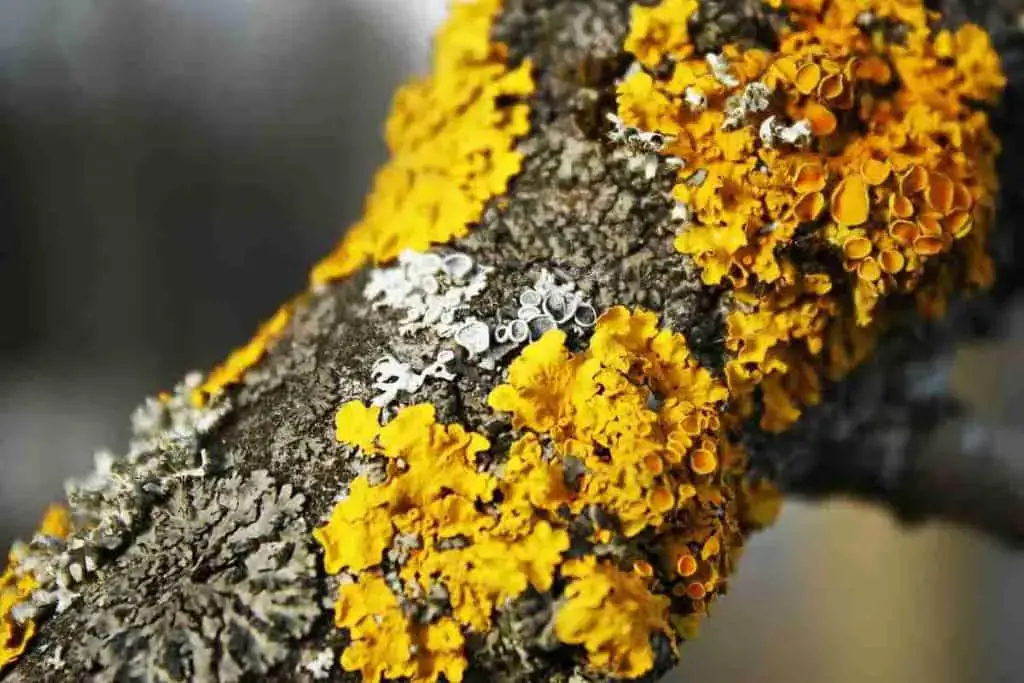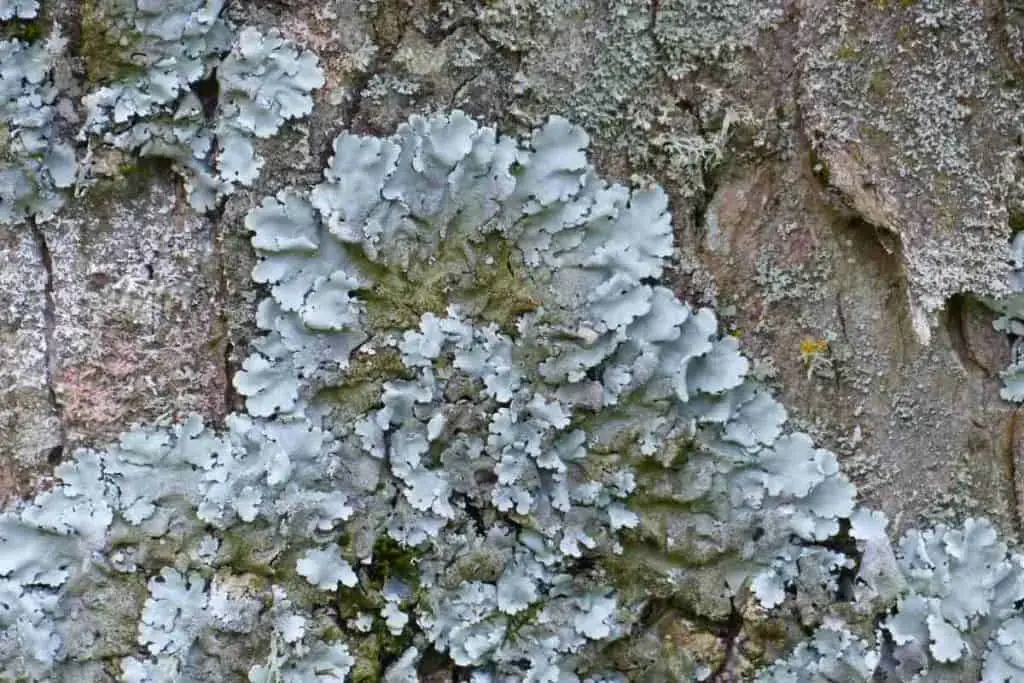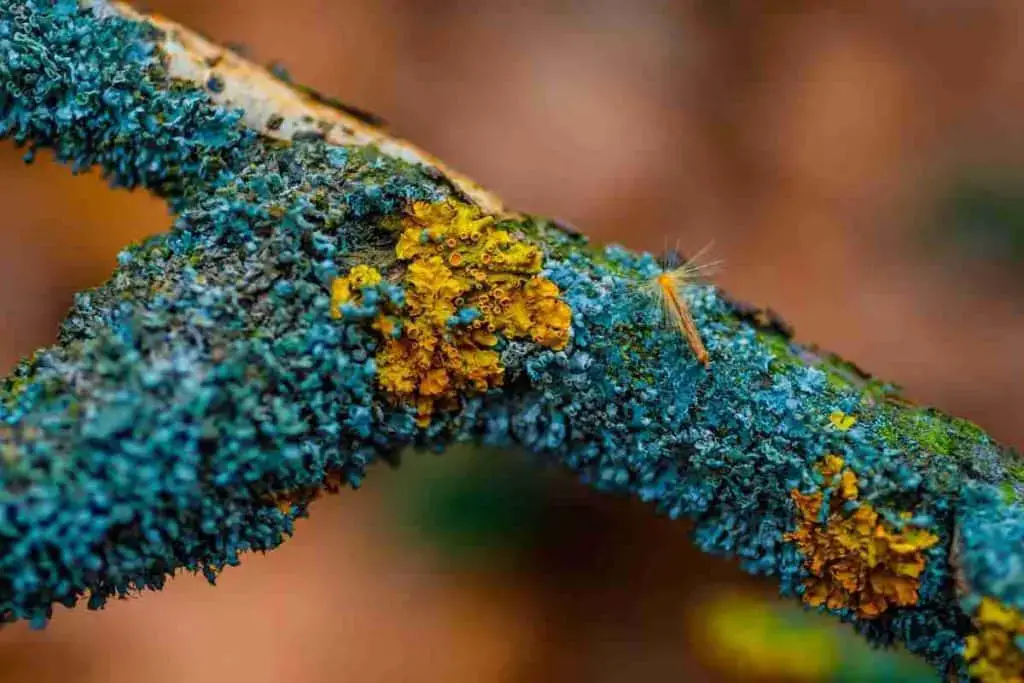Did you know, that there are over 3.500 different types of lichens worldwide, making them one of the largest groups of organisms on the planet. Lichens come in a wide variety of colors, shapes, and sizes, and can be found growing on just about any type of surface.
Lichens are actually a symbiotic relationship between two different organisms – fungus and algae!
While lichens may not look like much, they are actually very important to the environment and provide food for a variety of animals. Lichens are also used in traditional medicines to this day.
To give you an idea of the types of lichens that can be found around the world, we’ve put together a list of 22 different types of lichens and learn about their unique characteristics and where they’re found.
22 Different Types of Lichens
1. Usnea (Old Man’s Beard)
Usnea, also known as an (old man’s beard), is a type of fruticose lichen that can be found growing on tree branches. It gets its name from its long, string-like appearance similar to an old man’s beard, and is found growing throughout the United Kingdom and grows all year round.
| Color: | The upper surface is dark- yellowish-green to grey-green, and it has a black base. |
| Habitat: | Can be found growing and hanging off the branches of trees. |
| Characteristics: | It has a large bushy-like appearance with white ovals that are smooth in texture and can grow up to 10 cm long. |
You May Also Like To Read:
2. Ramalina fastigiate (cartilage lichen)
Ramalina fastigiate (cartilage lichen) is a type of fruticose lichen from the family Ramalinaceae. It’s commonly found growing in well-light woodland areas in Asia, Europe, and North America.
It’s easily identified by its flat, strap-like disc structure that has irregularly grey flattened stems 2-5cm in height which turn green when wet.
| Color: | It is grey-green when it’s dry and when wet, it appears green. |
| Habitat: | Can be found growing on tree trunks and branches. |
| Characteristics: | It’s slightly flattened with cylindrical discs that branch out up to 5cm long, and 3-8mm wide that appear pale to dark grey to green. |
3. Xanthoria Parietina (yellow scale Lichen)
Xanthoria Parietina, also known as (yellow-scale Lichen) is a type of lichen that can be found near the island shores.
It gets its common name from its yellow-orange coloration caused by the presence of carotenoid pigment in the lichen.
| Color: | Some specimens are more orange while others are more yellow. |
| Habitat: | Can be found growing near the shore on rocks, inland rocks, walls, or tree bark. |
| Characteristics: | They have Lobed margins with wrinkled centers, which are 0.7-3.5mm wide. |
4. Candelariella Reflexa (egg yolk lichen)
Candelariella Reflexa (egg yolk lichen) is a type of lichen that prefers shaded areas with nutrient-rich woody surfaces. This one can be identified by its mustard yellow and green appearance which is made up of numerous small, round granules.
This lichen does well in cold climates and can be found growing in Ireland and is very common in the United Kingdom!
| Color: | Bright yellow and green granules. |
| Habitat: | Can be found on logs and trees that are nutrient-rich and shaded from the sunlight. |
| Characteristics: | Small tufts or patches that can reach anywhere from 1 to 2cm in diameter. |
5. Hypogymnia physodes (monk’s-hood lichen)
Hypogymnia Physodes, commonly known as the (monk’s-hood lichen) is a type of lichen that can be found growing on rocks, trees, or mossy soil in cold, mountainous regions.
It is easily identified by its hood-like shape and grey-green coloration.
| Color: | Grey-green lobes with brown margins. |
| Habitat: | Prefers shady, humid conditions and can be found in Europe and other parts of the world. |
| Characteristics: | Swollen grey-green lobes lichens that are 6-8cm broad, cartilaginous texture, with budding. |

6. Canoparmelia Texana (Texas Lichen)
Canoparmelia Texana, also known as the (Texas Lichen) is a type of foliose lichen lives growing in open areas that can be found growing on trees or rocks.
It gets its common name from the state it is most commonly found in, which is Texas. The lichen itself is very light, almost white in color with powdery soredia and brown underside.
| Color: | Very light, almost white in color |
| Habitat: | Loves open areas that can be found growing on trees or rocks. |
| Characteristics: | They grow from 4- 12 cm wide in diameter with irregular lobes of up to 3-5mm wide. |
7. Hypotrachyna livida (Hypotrachyna Lichen)
Hypotrachyna Livida, or (Hypotrachyna Lichen) is a type of lichen that can be found growing in forest woodlands and typically grows on hardwood bark and acidic rocks. These types of lichens are commonly found in North America, Europe, and Asia and prefer shady, humid conditions.
The thallus is 2-9cm in diameter. It is fragile; its lobes are initially spread 1-2mm wide. The upper surface is shiny, smooth, and whitish gray. The lower surface has black tips. They lack fine projections.
| Color: | Gray to ashy white with a brown underside. |
| Habitat: | Likes humid conditions and is commonly found in North America, Europe, and Asia. |
| Characteristics: | The upper surface is shiny, smooth, and whitish gray. The lower surface has black tips. |
8. Umbilicaria mammulata (Rock tripe)
Umbilicaria Mammulata, also known as (Rock tripe) is a type of foliose lichen that can be found on rocks, walls, in forests, or around lakes. It gets its common name from its stripe-like appearance and its dark brown coloration.
It is the largest Lichen in the world 4-15cm in diameter. If the condition is perfect, they can grow up to 15cm long and a huge width.
| Color: | Its upper part is reddish-brown to grayish-brown, and the lower surface is pitch-black. |
| Habitat: | Grows on rocks, walls, forests, or around lakes. |
| Characteristics: | The thallus is umbilicate, continuous, and diffuse. It has no branches, lobes, or areola. It is 4 to 15 cm in length and has a width of up to 5.9. |
9. Usnea strigose (bushy beard lichen)
Usnea strigose lichen also known as (bushy beard lichen) grows well in lit habitats such as trees near rivers. It normally has a pretty appearance, often with large fruiting cups on the terminal of the Lichen’s branches.
Its most frequent host is an oak tree which is also shrubby with very long branching. It also has an unpigmented medulla.
| Color: | Dark yellowish to gray-green. |
| Habitat: | Found close to streams, forest edges, and hillsides and is native to Europe and southwestern Asia. |
| Characteristics: | It has 2-5 long branching that is cylindrical to tapering and lateral branches. Absent to few fibrils 1-2mm in length. It also has terminal apothecia of width 5mm. |
10. Parmotrema perlatum (black stone flower)
Parmotrema perlatum, commonly known as the (black stone flower), is a species of tree that is native to tropical regions around the world. With its broad, dark green leaves and striking black flowers, this tree is an iconic sight in many rainforests and wooded areas and is often used as a spice throughout India.
| Color: | The lichen is gray with some black and brown areas. |
| Habitat: | Usually grows on trees and rocks with open habitats. |
| Characteristics: | This species is 3-15 mm in diameter and has elongated lobes of 8-18mm. The cilia are 0.3-2.0 mm long. |
11. Punctelia rudecta (speckle back lichen)
Punctelia Rudecta, also known as (speckle back lichen) is native to North America. The thallus is mostly 3–8 mm (0.1–0.3 in) wide and has a dark greenish-gray to almost blue-gray color.
It is a small, black lichen with white spots that resemble tiny stars that speckle getting its name from that. It can be found attached to the back of rocks that are shaded.
| Color: | Has a dark greenish-gray to almost blue-gray in color. |
| Habitat: | Can be found attached to the back of rocks and is native to North America. |
| Characteristics: | It has large lobes at the edges of the colony. It has a medium size of up to 8cm. The upper surface of the lobe spreads to a width of 4-7mm. |

11. Flavoparmelia caperata (green shield lichen)
Flavoparmelia Caperata, also known as the common (Green Shield Lichen) is a type of foliose lichen that can be found growing on tree bark or rocks in shady areas.
It’s a very large type of lichen and is also very distinctive that has a yellowish color that gets brighter and thickens when wet. When dry it has a more yellowish-green color on the cortex.
The lobes are round and measure 3-8mm wide. However, the older lobes appear wrinkled while the fresh ones appear smooth.
| Color: | Smooth yellowish color when wet that turns yellow-green when dry. |
| Habitat: | Grows tree bark on rocks mainly in shaded areas. |
| Characteristics: | The lobes are smooth and round that measures 3-8mm yet older types have a more wrinkled appearance. |
12. Xanthoparmelia conspersa (peppered rock shield)
Xanthoparmelia Conspersa, known as the common (peppered rock shield) is a foliose lichen that can be found on trees, soil, or rocks in shady areas and prefers cool, moist conditions.
Some of these types of lichens are either tightly or loosely attached to their surfaces. The thallus measure between 4–12 cm have narrow lobes tip 1–3 mm wide and is pale to dark brown in color the rhizines are black.
They mainly grow on rocks getting the name rock shield and can be found in Europe, Africa, Japan, North America, and South America.
| Color: | The lower surface of the thallus is black and the tips of the lopes are pale to dark brown. |
| Habitat: | Prefers well-lit areas usually on trees, nutrient-enriched rocks, and wooden fences. |
| Characteristics: | The tips of the lopes are crowded and usually overlapping and the upper surface ranges in shape from spherical to branched. |
13. Cladonia cristatella (British soldier’s lichen)
Cladonia Cristatella, also known as the (British soldier’s lichen) is a type of fruticose lichen that can be found growing on soil or tree bark in shady areas.
It gets its common name from the fact that the tips of its branches resemble the redcoats of British soldiers. These types of lichens can be found throughout the northeastern USA into Canada.
| Color: | Their surrounding color is gray-green, and they possess bowl-shaped cups which are red. |
| Habitat: | They grow in areas where pollution is high, like in urban areas near roads. |
| Characteristics: | The British soldiers are shrubby and look like match sticks. |
14. Platismatia glauca (crumpled rag lichen)
Platismatia Glauca, also known as the (crumpled rag lichen) is a type of foliose lichen that can be found growing on tree bark or rocks in shady areas. It gets its common name from the fact that its leaves are wrinkled and resemble rags.
Its leaves are gray-green with brown edges and the body has a dusty patch that feels like crumpled paper. Their preferred habitat is the twigs of trees and trunks in forests from the southern Appalachians east to Nova Scotia.
| Color: | Gray-green with brown edges. |
| Habitat: | Grows in shaded areas usually on tree bark or rocks around the Great Lakes region east to Nova Scotia. |
| Characteristics: | Leaves are wrinkled and resemble rags that feel like crumpled paper. |

15. Rhizocarpon geographicum (map lichen)
Rhizocarpon Geographicum, also known as the (map lichen) can be found growing in mountainous areas that have low air pollution. They typically grow on rocks forming patches that resemble a map-like appearance.
It’s bright yellow or greenish-yellow and prefers cool, moist conditions. The lichen has also been recorded as the oldest living organism on Earth. Some of these have been found in the arctic with an age estimated of 8,600 years.
| Color: | The surface is bright yellow or greenish-yellow. |
| Habitat: | Can be found growing in cool, moist mountainous areas that have low air pollution. |
| Characteristics: | Forms patches that resemble a map-like appearance. |
16. Lecidia atrobrunnea (crustose lichen)
Lecidia Atrobrunneola, also known as (crustose lichen) is another type of lichen that can be found growing in mountains of the continental western United States and also Alaska.
It can be found growing on rocky surfaces in shady areas and prefers cool, moist conditions.
| Color: | The surface is pale brown and green with the lower surface usually black. |
| Habitat: | Grows on rocky surfaces in shady areas and prefers cool, moist mountainous areas. |
| Characteristics: | Forms small clusters completely covering rocky surfaces giving it the appearance of being painted on. |
17. Evernia prunastri (oakmoss)
Evernia Prunastri, also known as (oakmoss), is another type of lichen that can be found growing in mountainous areas. It can be found on the trunk and branches of oak trees getting its name oakmoss.
It’s very bushy, and when grown, they form large clumps (3–4 cm in length) and vary in color from green to a greenish-white when dry, or dark olive-green to yellow when wet.
| Color: | Green to almost white when dry, or dark olive-green to yellow when wet. |
| Habitat: | Grows in mountainous areas are typically on tree trunks and branches. |
| Characteristics: | Forms large clumps that are rough when dry and rubbery when wet. |
18. Cladonia rangiferina (reindeer cup lichen)
Cladonia rangiferina, also known as (reindeer cup lichen), is a light-grey colored foliose lichen that can grow in both hot and cold climates. This lichen is extensively branched and sometimes divides into two, three, or even four thicker branches that are 1–1.5 mm.
It can be found on the ground usually in humid, open forests, and rocky areas.
| Color: | The color ranges from various shades of brown-gray or whitish to pale green. |
| Habitat: | Grows in humid, open forests, and rocky areas. |
| Characteristics: | It grows up to 8 cm high, it has many branches, and each of its branches is divided four times. The branches are 1- 1.5mm in diameter. |
19. Cetraria Islandica (Iceland moss)
Cetraria Islandica, also known as (Iceland moss), is a type of lichen that grows erect or upright, leaflike, and gives a moss-like appearance. It grows in height between 3 to 4 in that has flattened lobes and fringed edges.
These lichens can be found growing on the mountains in and around the united kingdom and southwest Ireland.
| Color: | It varies in color from deep brown to grayish-white. |
| Habitat: | Grows in damp and partially light mountainous areas. |
| Characteristics: | Grows erect or upright, leaflike, and gives a moss-like appearance |
20. Cladonia Fimbriata (trumpet cup lichen)
Cladonia Fimbriata, also known as (trumpet cup lichen) has a very unique appearance. It can be found in form of a rosette that is 2–3 cm wide with narrow, upright, and branched stems. The tips of the branches have a cup-like structure that resembles a trumpet.
It got its name, the trumpet cup, from the formation of its leaves which are 2-6mm wide. The thallus of this species grows up to 6mm long and 4mm wide and has uneven lobes that sometimes break into masses with a length of 40mm tall and a width of 1-2mm.
| Color: | Whitish-gray lobes with a white medulla and apothecia |
| Habitat: | Grows on rotted wood and on top of the soil. |
| Characteristics: | Branches have a cup-like structure that resembles a trumpet that grows up to 6mm long and 4mm wide. |
21. Letharia vulpine (wolfs foot lichen)
Letharia vulpine, also known as (wolf’s-foot lichen), can be found on the bark of trees in shady areas. It can be found in North America, Europe, and Asia and prefers cool, moist conditions.
This lichen gets its common name from the fact that its branches fork at the tips that resemble the footprints of wolves. It is shrubby and highly branched and can grow up to 20cm tall and 3.8cm wide.
| Color: | Bright yellowed or lemon yellowed and green, while older branches are greenish-gray |
| Habitat: | Grows on the bark of living and dead wood and bark. |
| Characteristics: | Branching is irregular, often forked towards the end of the tips |
22. Aspicilia cinerea (cinder lichen)
Aspicilia Cinerea, also known as (cinder lichen), is a type of foliose lichen that can be found growing on rocks in mountainous shady areas. It is a light gray color with a smooth surface and grows in circular patches that can measure up to 5 cm wide.
Its areolas are flat or convex with a 0-2mm diameter. They appear separated well by the fine cracks at the surface and each areole has apothecia that are irregularly varying from 1-10mm. The thallus presents with concave discs with margins.
| Color: | Light gray color |
| Habitat: | Found growing on rocks in mountainous shady areas |
| Characteristics: | Appears separated by the fine cracks at the surface and each areole has apothecia 1-10mm |
Final Thoughts
So there are 22 different types of lichens that can be found growing in various parts of the world. Each type has its own unique appearance and prefers different conditions.
Some types of lichens can even be used for medicinal purposes. If you like these articles don’t forget to check out our website for more similar content.